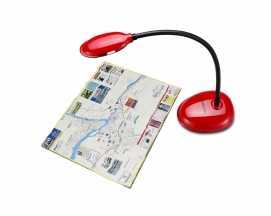Then share your views in the forum, and/or make notes in your blog, about the following issues:
What do you think is the likely impact of this technology on the students’ perceptions of the quality of their modules, their approaches to studying and their academic performance?
The technology I am going to refer to is the use of a Ladibug device. This slim piece of hardware looks like a desk lamp with a large plastic ladybird as its head. It is operated through companion software and is therefore connected to the PC and any existing OHP. In Bishop Auckland HE Centre this is a ceiling set OHP.
 The Ladibug once activated projects an image of any document placed below it at great and very clear magnification. It appears to self-focus (certainly I did nothing to achieve a clear image).
The Ladibug once activated projects an image of any document placed below it at great and very clear magnification. It appears to self-focus (certainly I did nothing to achieve a clear image).
This allows an A4 page completed by a student or student group to be projected for the purpose of a group or individual presentation. Of course tutors can with this share textual or graphic documents or put up a stimulus for an exercise.
It is promoted by the college as an alternative to the use of flip-chart paper and pens for group presentations.
The advantage of this device is that it is an easily learnable device that can put students in control of elements of a teaching plan, reporting back from private study or sharing a stimulus with their work group or whole class. Images can be captured and later distributed either electronically or printed.
When I used it for group work I was disappointed. An A4 sheet is insufficiently communal and groups tended to atomise rather than cohere around it as I have seen happen with flip-chart paper and pen. I think in future I would ask students to prepare a segment of the whole page based on a master-plan which the group would re-assemble (making group changes) at the end. My fear is that group work in F2F events may lose coherence.
What do you think is the likely impact of this technology on the teachers’ perceptions of their teaching context and their approaches to teaching?
It might increase the use of shared stimulus (text or graphic) without recourse to a photocopier and emphasise the need for literature search. However Ladibug does capture images, so complex stimuli can be given out at the ends of class or sent to an email distribution list. Think of the cost savings on printing, colleges!
Teachers may see the Ladibug as like the conch in Lord of Flies since who holds it has the 'floor' and this may cause more democratic (or less autocratic) teaching practices to emerge!
Do you think this technology embodies particular assumptions about the nature of teaching and learning in higher education?
In this case no, since its use rather than its nature will determine the nature of T & L. As with any other technology, it is a slave rather than a master of 'learning design!'
If so, what are these assumptions? Are they likely to promote more positive perceptions, more desirable approaches to studying and better performance on the part of the students?
Given my (convenient) view on the question above, there is less to say here. I do think learning design the prior thing, so much so that its role is iterative - review of LD leads to redesign and so on, ad infinitum.
So having less to say than I thought, I'd like to share a resource (from St. Clair, R. (2015) Creating Courses for Adults: Design for Learning San Francisco, Jossey-Bass p. 150) - my book at bed-time.
|
Table 1: Selected Teaching Methods |
||||
|
Tasks |
People |
|||
| Individual |
Small Groups |
Whole Group |
The model is surely, Steve thinks at least, about the combination of different forms of PARTICIPATION and ACQUISITION. Both can happen in any social group size.
See Danny’s comments on Ex. 2 Week 12 |
|
|
Respond |
Journals Blogs Presentations |
Feedback Presentation |
Lecture Debate Panel Interviews |
|
|
Create |
Research Projects |
Problem Solving Research Case Studies Presentations |
Twitter comments Collective curriculum |
|
|
Combine |
Wikidocs |
Comparison Collective response Role plays |
Voting Q & As |
|
|
This model is LED by task and the combination of tasks into whole design. The table shows how different methods could be used in places where they might be meet a task requirement. Steve disagrees with some of the placements (surely Wikidocs are, at best, not ‘individual’) but we have seen problems with this elsewhere in H800. However, the base words (e.g. respond) really get to the nitty-gritty of design |
||||
Comments
New comment
"An A4 sheet is insufficiently communal and groups tended to atomise rather than cohere around it as I have seen happen with flip-chart paper and pen"
Such an interesting piece of technology Steve, not one I'd come across before. I agree with your statement above for "workshop" size sessions (small groups in your great table) however when I run sessions with very senior leadership, who can "hog" or find "flipchart" activity a bore, they often like to scribble thoughts as we go and this would be hugely valuable in those instances.
I hope you're getting shares
Emma